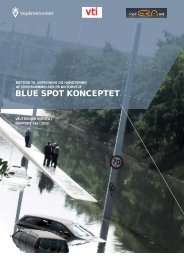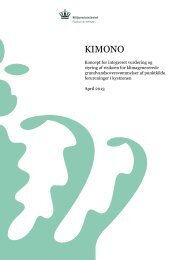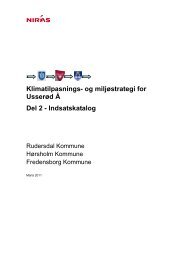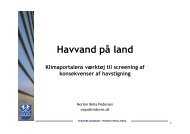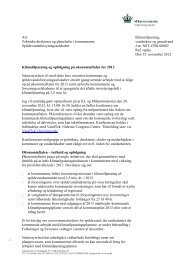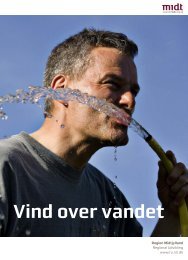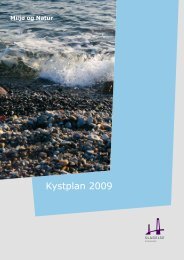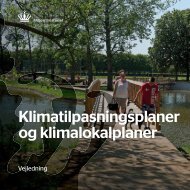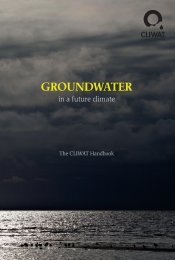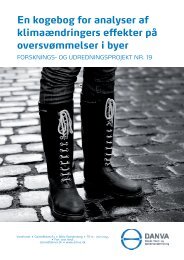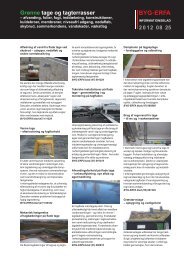Mapping climate change - barriers and opportunities for action
Mapping climate change - barriers and opportunities for action
Mapping climate change - barriers and opportunities for action
You also want an ePaper? Increase the reach of your titles
YUMPU automatically turns print PDFs into web optimized ePapers that Google loves.
3. A common starting point <strong>for</strong> <strong>climate</strong> <strong>change</strong> adaptation ef<strong>for</strong>ts<br />
With focus on 2050, the Danish Meteorological Institute has described the projected future <strong>climate</strong><br />
<strong>change</strong>s in Denmark based on the most recent Danish <strong>and</strong> European scenario simulations.The<br />
assessment of future <strong>climate</strong> <strong>change</strong> is based on the same scenarios that are used by the UN<br />
Intergovernmental Panel on Climate Change (IPCC). Changes are expected to increase towards<br />
2100.<br />
As a common starting point <strong>for</strong> <strong>climate</strong> <strong>change</strong> adaptation in Denmark, since 2010 the<br />
recommended <strong>climate</strong> scenario has been the A1B scenario from the Intergovernmental Panel on<br />
Climate Change (IPCC) <strong>for</strong> the period up to 2050, as there are only minor differences between the<br />
different <strong>climate</strong> scenarios over this relatively short time span. For the period up to 2100, the<br />
<strong>climate</strong> model projections are much more reliant on the emissions scenario applied. On the basis of<br />
the Danish strategy <strong>for</strong> adaptation to a changing <strong>climate</strong> from 2008, in addition to results <strong>for</strong> A1B<br />
(an average scenario), descriptions <strong>for</strong> two of the IPCC's other SRES scenarios: B2 (an average-low<br />
scenario) <strong>and</strong> A2 (an average-high scenario), are included here in order to illustrate the range. The<br />
Danish Meteorological Institute has moreover per<strong>for</strong>med calculations <strong>for</strong> a scenario which assumes<br />
global anthropogenic increases in temperature of no more than 2ºC relative to the pre-industrial<br />
level. This scenario is called 2C.<br />
Climate simulations <strong>and</strong> our underst<strong>and</strong>ing of the uncertainties linked to them are improving all the<br />
time. The Danish Meteorological Institute has calculated the figures in the tables presented in the<br />
following <strong>and</strong> these figures are the most recent figures, based on EU studies in which a number of<br />
<strong>climate</strong> simulations were run with several regional <strong>climate</strong> models 1 . Thus the assessments of future<br />
<strong>climate</strong> <strong>change</strong> will be much more robust than if the figures had been based on only a single <strong>climate</strong><br />
model. The tables give the mean value of the model as best estimate, <strong>and</strong> the uncertainty range<br />
indicates the st<strong>and</strong>ard deviation from the mean value of the results from the different models. This<br />
means that, with the assumptions underlying the model simulations, there is a 68% probability that<br />
a given future value will fall within the range.<br />
Future global sea level rises depend on the melting of snow <strong>and</strong> ice as well as on increases in ocean<br />
temperature. Projections of ice melt are associated with great uncertainty, <strong>and</strong> estimates <strong>for</strong> sea<br />
level rises <strong>for</strong> the 21st century are there<strong>for</strong>e rarely linked to a well-specified <strong>climate</strong> scenario. The<br />
sea level rises described in the following are best estimates by the Danish Meteorological Institute<br />
<strong>and</strong> the Geological Survey of Greenl<strong>and</strong> <strong>and</strong> Denmark on the basis of existing studies, <strong>and</strong> the<br />
uncertainty range corresponds to a st<strong>and</strong>ard deviation.<br />
When planning, assessing <strong>and</strong> per<strong>for</strong>ming risk analyses in connection with <strong>climate</strong> <strong>change</strong><br />
adaptation, it is important to think carefully about whether to include the whole spectrum of values<br />
(as given by the uncertainty range) or to include only the indicated best estimate.<br />
3.1 IPCC projections of future <strong>change</strong>s in <strong>climate</strong><br />
In its fourth <strong>and</strong> most recent report (Fourth Assessment Report (AR4) from 2007), the<br />
Intergovernmental Panel on Climate Change (IPCC) concluded that there is a more than 90%<br />
probability that most of the observed global warming since the middle of the 20th century can be<br />
attributed to anthropogenic greenhouse gases. It is moreover very likely that continued emissions, at<br />
1 An ensemble of 14 model runs is included <strong>for</strong> the year 2050 <strong>and</strong> an ensemble of 8 <strong>for</strong> the year 2100.<br />
13



